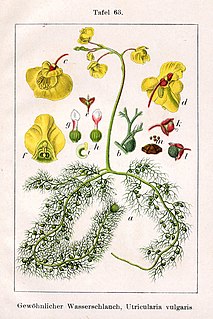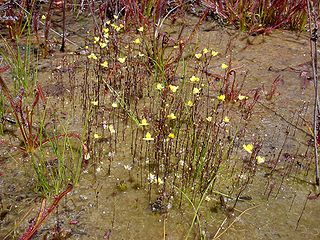
Utricularia, commonly and collectively called the bladderworts, is a genus of carnivorous plants consisting of approximately 233 species. They occur in fresh water and wet soil as terrestrial or aquatic species across every continent except Antarctica. Utricularia are cultivated for their flowers, which are often compared with those of snapdragons and orchids, especially amongst carnivorous plant enthusiasts.
Utricularia trichophylla is an aquatic or terrestrial carnivorous plant that belongs to the genus Utricularia. It is native to Central and South America where it can be found in Belize, Bolivia, Brazil, French Guiana, Guyana, Nicaragua, Paraguay, Peru, Suriname, Trinidad, and Venezuela.

Utricularia triloba is a small annual, terrestrial carnivorous plant that belongs to the genus Utricularia. It is native to Central and South America and is found in the following countries: Argentina, Belize, Bolivia, Brazil, Colombia, French Guiana, Guyana, Paraguay, Peru, Suriname, and Venezuela.

Utricularia sect. Avesicaria is a section in the genus Utricularia. Both species in this section are endemic to Central and South America.
Utricularia cucullata is a small suspended aquatic carnivorous plant that belongs to the genus Utricularia. U. cucullata is endemic to South America and can be found in Brazil, French Guiana, Guyana, Suriname, Trinidad, and Venezuela.
Utricularia myriocista is a medium-sized suspended aquatic carnivorous plant that belongs to the genus Utricularia. U. myriocista is endemic to South America and can be found in Argentina, Bolivia, Brazil, French Guiana, Guyana, Suriname, Trinidad, and Venezuela.
Utricularia sect. Steyermarkia is a section in the genus Utricularia. The three species in this section are small lithophyte carnivorous plants native to South America. Both U. aureomaculata and U. steyermarkii were previously included in U. sect. Setiscapella until Peter Taylor split them off from it in 1989 with the creation of section Steyermarkia. He did this on the basis of the very different seeds and multinerved leaves seen in these two species. Utricularia cochleata was described in 2008 and added to this section after these taxonomic shifts. This section is named in honor of Julian Alfred Steyermark.
Utricularia tenuissima is a small, annual, terrestrial carnivorous plant that belongs to the genus Utricularia and is the only member of Utricularia sect. Martinia. U. tenuissima is endemic to South America, where it can be found in Brazil, Colombia, Guyana, Suriname, Trinidad, and Venezuela. It grows as a terrestrial plant in wet, open savanna usually in sand at altitudes from sea level to 2,100 m (6,890 ft). It was originally published and described by Thomas Gaskell Tutin in 1934 and placed in its own section, Martinia, in 1986 by Peter Taylor.
Utricularia guyanensis is a small, probably perennial, terrestrial carnivorous plant that belongs to the genus Utricularia and is the only member of Utricularia sect. Stylotheca. U. guyanensis is native to Central and South America. It grows as a terrestrial plant on wet or damp sandy savannas at lower altitudes, but up to 1,100 m (3,609 ft) in Bolívar. It has been collected in flower between January and November. It was originally published and described by Alphonse Pyrame de Candolle in 1844 and placed in its own section, Stylotheca.
Utricularia choristotheca is a very small, probably perennial, rheophytic carnivorous plant that belongs to the genus Utricularia. U. choristotheca is endemic to Suriname, where it is only known from the type location, and French Guiana, where it is found on Montagne des Nouragues. It grows as a rheophyte on bare granite rocks in dripping water at altitudes up to 900 m (2,953 ft). It has been collected in flower or fruit in July. It was originally described and published by Peter Taylor in 1986.
Utricularia determannii is a very small, probably perennial, rheophytic carnivorous plant that belongs to the genus Utricularia. U. determannii is endemic to Suriname, where it is only known from the type location in the Wilhelmina Mountains. It grows as a rheophyte on bare granite rocks in dripping water at altitudes up to 900 m (2,953 ft). It has been collected in flower in July. It was originally described and published by Peter Taylor in 1986 and named in honor of the American collector R. O. Determann.
Utricularia sect. Mirabiles is a section in the genus Utricularia. The two species in this section are small or medium-sized rheophytic carnivorous plants. Peter Taylor originally described and published the section in 1989, splitting the two species off from section Avesicaria on the basis of the dissimilar rhizoids, traps, corolla spur, and seeds. Both species are endemic to Venezuela.
Utricularia viscosa is a small to medium sized perennial, terrestrial or subaquatic carnivorous plant that belongs to the genus Utricularia and is the only member of Utricularia sect. Sprucea. U. viscosa is native to Central America and South America. It grows as a terrestrial or subaquatic plant in wet sandy savannas at lower altitudes but as high as 900 m (2,953 ft) in Guyana. It was originally named by Richard Spruce and formally described by Daniel Oliver in 1860. In 1986, Peter Taylor placed this species in its own section, Sprucea, which was named in honor of Richard Spruce.
Utricularia sect. Avesicarioides is a section in the genus Utricularia. The two species in this section are small rheophytic carnivorous plants native to western Africa. Sadashi Komiya originally described and published this section in his 1973 taxonomic treatment of the genus. Peter Taylor revised and refined the section in his 1989 monograph on the genus.
Utricularia sect. Enskide is a section in the genus Utricularia. The two species in this section are small to medium-sized terrestrial carnivorous plants native to Australia and New Guinea. Constantine Samuel Rafinesque originally described and published this section as a separate genus in his 1838 taxonomic treatment. Peter Taylor refined the section and placed it within subgenus Utricularia in his 1986 monograph of the genus. Later molecular data resulted in the revision of Taylor's treatment, reinstating subgenus Bivalvaria and placing this section within it.
Utricularia longeciliata is a small to medium-sized perennial carnivorous plant that belongs to the genus Utricularia. U. longeciliata is endemic to South America, where it can be found in Brazil, Colombia, Guyana, Suriname, and Venezuela. It grows as a terrestrial plant in damp, sandy soils at altitudes from near sea level to 1,400 m (4,593 ft). It flowers throughout the year in its native range. U. longeciliata was originally described and published by Alphonse Pyrame de Candolle in 1844.
Utricularia sandwithii is a small, probably perennial, carnivorous plant that belongs to the genus Utricularia. U. sandwithii is endemic to Brazil, Guyana, Suriname, and Venezuela. It grows as a terrestrial plant in damp, sandy soils in savannas at altitudes from near sea level to 600 m (1,969 ft). U. sandwithii was originally described and published by Peter Taylor in 1967 for the Botany of the Guyana Highland series, though it was probably collected as early as 1851 by Heinrich Wullschlägel in Suriname. It had also been collected by George Samuel Jenman in 1881 in Guyana, but was overlooked until Taylor presented his work in 1967.
Utricularia erectiflora is a small, probably perennial, carnivorous plant that belongs to the genus Utricularia. It is native to Central and South America and can be found in Belize, Bolivia, Brazil, Colombia, Ecuador, Guyana, Nicaragua, Suriname, and Venezuela. U. erectiflora grows as a terrestrial plant in wet, sandy savannas, wet grasslands, or marshes. It was originally described and published by Augustin Saint-Hilaire, and Frédéric de Girard in 1838.
Utricularia sect. Phyllaria is a section in the genus Utricularia. The sixteen species in this section are small or very small lithophytic or epiphytic carnivorous plants native to the mountains of Asia, ranging from India to China and New Guinea. One species, Utricularia striatula, is an exception and is widespread in much of the Old World tropics. Wilhelm Sulpiz Kurz originally described and published this section as Utricularia subg. Phyllaria in 1874. Franciszek Kamieński reviewed the genus in 1891 and reduced Kunz's subgenus to a section. Later botanists, including Peter Taylor, agreed with Kamieński's assessment. In Taylor's 1986 revision of the genus, he placed this section in subgenus Utricularia. Later molecular data resulted in the revision of Taylor's treatment, reinstating subgenus Bivalvaria and placing this section within it.

The Genus Utricularia: A Taxonomic Monograph is a monograph by Peter Taylor on the carnivorous plant genus Utricularia, the bladderworts. It was published in 1989 by Her Majesty's Stationery Office (HMSO) as the fourteenth entry in the Kew Bulletin Additional Series. It was reprinted for The Royal Botanic Gardens, Kew in 1994.



